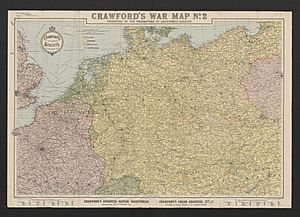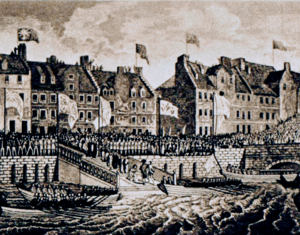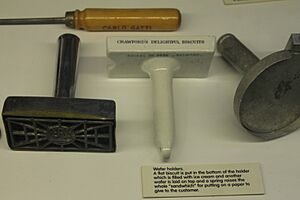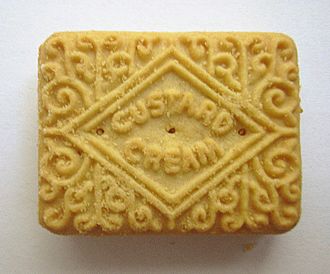Crawford's facts for kids
Crawford's is a well-known brand that makes delicious biscuits. It started a long time ago in Scotland.
The company began as a small bakery in 1813. It was located in a public house on The Shore, Leith. At first, they mainly made "ship's biscuits." These were hard biscuits that sailors could eat on long voyages.
In 1856, William Crawford bought the bakery. He wanted to make the business much bigger. Soon, his company, William Crawford & Sons, built large factories. These were in Leith, Scotland, and Liverpool, England. At its best, Crawford's was one of Britain's biggest biscuit makers. They even said they were the oldest!
In 1960, a company called United Biscuits bought Crawford's. Today, Crawford's is still a popular brand under United Biscuits.
Contents
The Story of Crawford's Biscuits
How It All Started
The bakery that became Crawford's began in 1813. It was on The Shore in Leith, Scotland. In 1817, a man named Robert Mathie took over the bakery. They were famous for making biscuits for ships.
In 1856, William Crawford (who lived from 1818 to 1889) bought the bakery from Robert Mathie. William wanted to grow the business.
Growing the Business
William Crawford opened a shop in Leith in 1861. Later, in 1866, he moved the shop to a fancy address on Princes Street.
In 1879, they built a huge, special factory on Elbe Street in Leith. This factory even had its own railway line! This helped them move ingredients and biscuits easily. Another factory was built in Leith in 1947.
William's oldest son, William Crawford (1858–1926), joined the business in 1880. He helped it grow even more. The company then became known as Crawford and Sons.
Expanding to Liverpool
In 1897, two of William's younger brothers, Archibald and James, planned to start a new branch in Australia. But they stopped in Liverpool, England. There, they decided to build a huge new factory instead!
This factory was called the Fairfield Works. William's brother, Alexander Hunter Crawford, designed it in 1895. It took two years to build. The Liverpool factory used many machines. This allowed them to create more detailed biscuit designs. The Custard cream biscuit became very popular. It was one of Britain's favorite biscuits! The Fairfield factory also made snack bars like Penguin.

Looking After Employees
In 1927, Crawford's was one of the first factories to offer a social club and sports facilities for its workers. This was at Sandown Hall in Wavertree.
In 1938, Crawford's did the first ever national survey about biscuits in Britain. They talked to about 5,000 families to learn what people liked.
Changes and Challenges
In 1948, a company called United Biscuits was formed. It was made from two other Scottish companies. In 1960, United Biscuits bought William Crawford & Sons for £6 million.
In the 1960s, the way biscuits were made became more automated. This means machines did more of the work.
The Elbe Street factory in Leith was made bigger and more modern in the 1950s. But it was torn down in the 1990s. This happened as the old industrial areas of Leith changed into new housing. About 200 people lost their jobs when the factory closed in 1996.
Popular Crawford's Biscuits
In 1923, Crawford's advertised several biscuits that celebrated royal events. These included:
- York – for the marriage of the Duke of York
- Wedding Bells – for the marriage of Princess Mary
- Marie – for the marriage of Grand Duchess Maria Alexandrovna of Russia
- Royal George
Their range of biscuits also included popular types like shortbread, cream crackers, digestives, and ginger nuts.
Today, the Crawford's brand still makes many favorite biscuits. These include:
- Bourbon creams
- Cream crackers
- Custard creams
- Digestives
- Garibaldi biscuits
- Marie biscuits
- "Nice" biscuits
Special Packaging
In the past, some of Crawford's biscuits came in beautiful, decorative biscuit tins. These tins were often very special. In 2007, a Crawford's biscuit tin shaped like a sports car was sold for a lot of money. It sold for £15,600! At the time, it was said to be the most expensive biscuit tin ever sold.




